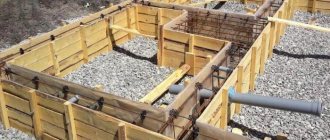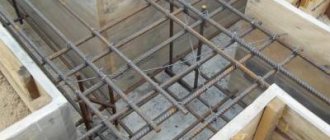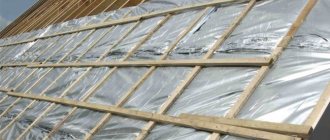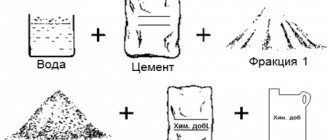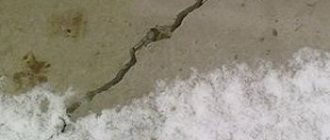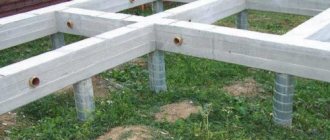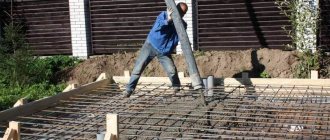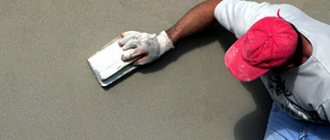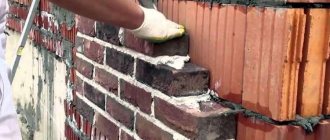Before you begin laying the concrete mixture into the formwork, it is important to check the serviceability of the structure, the fastening of the formwork, and inspect the scaffolding, linings, and jointing.
Before laying concrete into the formwork, you need to check if there are any cracks in the structure.
When placing concrete into formwork, there are a number of requirements that must be met.
Often, gaps are found in the formwork that must be sealed. After inspection and repair, the concreting formwork must be cleaned of dirt, chips and other debris. It is important to thoroughly moisten the formwork with water. If this is not done, the laid concrete will transfer moisture to the dry boards of the structure.
Scheme of conventional foundation formwork.
The reinforcement used must also be freed from adhering soil if it was stored outdoors. Check whether plugs and anchor bolts are installed correctly. You should check the quality of the knitting. Concrete laying is carried out quickly, without stopping, any delays in this process are highly undesirable . Each subsequent concrete layer is laid and compacted before the layer laid earlier begins to set. At the same time, it is known that during concreting, interruptions in work are difficult to avoid.
In this case, the working seams are left in places where the formwork structure has the least stress. For example, when concreting columns, you can leave a working seam only at the beginning of the column. Sometimes it is located under the upper ceiling, under the purlin. When concreting ribbed floors is carried out, the seams in the direction of the purlins can be left in the middle part of the purlin span, near the middle of the slab span, since there are no bent rods there. Maximum attention is always paid to formwork for concreting; the outcome of the work depends on it.
Features of preparatory work
If the floors are beamless, the seams should be located at the middle of the span. As for wall joints, they can be made directly at the ceiling. Inclined seams cannot be made.
Any formwork for a strip foundation should be easily dismantled after the concrete has hardened.
Sometimes it happens that the concrete mixture still has to be laid on a layer that has long set or is old. In this case, before starting work, the surface of the old concrete is thoroughly cleaned. For this purpose, special wire steel brushes are used.
Often, such work is large-scale and requires cleaning a significant surface. You can’t get by with improvised means, so it is advisable to use grinding machines or special sandblasting machines.
During preparatory work of this type, shells or other defects are often found in the old concrete layer. In this case, it is necessary to cut down the surface layer of the old concrete coating without affecting the reinforcement. If there are areas of exposed reinforcement, you need to clean it thoroughly, remove rust and particles of the old concrete. The next step is to wet the old surface with cement laitance. Only after these steps can you begin laying concrete and a new layer. Its grade should be no lower than that previously used for the old layer.
Concrete supply from height
During construction work, concrete often has to be supplied from above, and such methods assume that the height can be significant. If the height is more than 2 m, then the concrete should be lowered into the formwork using special trays that have an inclined position. You can use gutters with canopies. If concrete is supplied from a height of 3 m, trunk pipes are installed that have an inclined position. The tilt angle here is 30°. If the concrete mixture is supplied to formworks located within a radius of up to 15 m, then the supply is carried out using metal vibrating robots.
Conducting vibration
Scheme of filling the formwork.
The concrete mixture is compacted using vibrators. During this action, air is displaced, bubbles are pushed out, and the volume of concrete becomes smaller. The vibrator should be immersed into the concrete smoothly, with a slight inclination. After vibrating one area is completed, the vibrator is moved to another location. It is important that the vibrator compacts the entire area occupied by the concrete so that voids, called cavities, do not appear in the concrete.
If vibrating a newly laid layer is required, the vibrator must be immersed in the concrete mixture in such a way that it does not reach the underlying layer. Otherwise, the structure of the mixture may be damaged. Vibration must be carried out at a certain distance from the formwork walls. Usually it is enough to leave 10 cm. If the concrete mixture is normally compacted, laitance will form on its surface and around the vibrator platform.
Laying concrete underwater
Concrete placement underwater can be done using drop-bottom buckets or the vertically moving pipe method. Buckets should be unloaded only after they touch the base or layer of previously laid concrete. With this method, some erosion of the concrete is inevitable.
Equipment for underwater concreting using the vertically moving pipe method consists of a pipe into which the concrete mixture is loaded into the wide upper cone-shaped part. The lower discharge end of the pipe must always be under the surface of freshly laid concrete so that the movement of the concrete mixture and water is minimal. A continuous flow of concrete is installed, and as the height of the laid concrete increases, the pipe rises. If, due to inattention, the contact between the end of the pipe and the concrete is broken, then the next batches of the concrete mixture should be thicker to compensate for the washout of cement with water.
In general, it is necessary to use mixtures with a high degree of workability to ensure that the concrete mixture flows laterally to the edges of the concrete form, and the angle of repose of the concrete should be small. During underwater work it is often necessary to place concrete on the rock surface. In such cases, it is important to prevent concrete from leaking out from under the formwork; A good way to achieve this is to attach a long strip of tarpaulin near the bottom edge of the formwork and load it with bags of crushed stone. Before concreting begins, silt and dirt must be removed from the base with a pump.
The success of underwater concreting using a vertically moving pipe depends on the reliability of the watertight seal at the lower end of the pipe, which is necessary to ensure that the concrete is not washed away at the beginning of concreting. One way to seal the pipe is to install a burlap plug at the mouth of the funnel after the pipe is suspended in its original position. When concrete is loaded into the funnel, this plug goes down, displacing air and water from the pipe. At the moment when the plug is pushed out of its lower end, the concrete mixture quickly flows out along with it, which immediately forms a mound that closes the exit from the pipe. Further flow of the concrete mixture is stopped by lowering the pipe to the bottom of the reservoir; At the same time, new portions of the concrete mixture are loaded into the funnel. The pipe is then slowly raised just enough to allow the concrete mixture to flow out evenly. Other methods have been used to stop the initial flow of concrete from the pipe.
Concreting of structures and elements
Construction of a monolithic foundation using wall formwork elements.
The process of concreting any structure always takes into account design features and a number of requirements. If the height of the column being constructed is more than 3 m, the concrete mixture is compacted in layers, tiers through windows located along the height of the column at intervals of 1.5 m. In this case, the concreting layer should not be more than 0.5 m. The layer is compacted with a vibrator in approximately 20 seconds. As a rule, concreting of columns is carried out at the same time as the beams that adjoin them and with the floor slabs.
After concreting is completed, 2 hours are allotted for settling the concrete in the column. Next, the adjacent elements begin to be concreted. Partitions and walls up to 20 cm thick are concreted in tiers, the height of which can reach 1.5 m, and then compacted. For concreting beams and purlins, a layer of up to 50 cm is taken. After sufficient compaction of the concrete mixture, the lighthouse slats are removed. The depressions left behind require careful compaction with concrete mixture and careful smoothing.
Compaction of slabs with sparse reinforcement
Removal of removable formwork.
If the surface of the slabs is more than 25 cm or they have sparse reinforcement, then compaction is carried out in the same way as for densely reinforced foundations. The same applies to slabs thicker than 25 cm with double reinforcement. After vibration is completed, the upper surface of the foundation must be leveled with a vibrating lath, then smoothed with a wooden lath. The floor is concreted along exposed beacons that determine its level. Taking into account the lighthouses, a layer of concrete is applied 20 mm higher than the height of the lighthouse. Compaction of the concrete mixture must be carried out until laitance begins to appear and the concrete drops to the level marked by the beacons.
The best option is to lay concrete in strips (1 m wide). If it is necessary to concrete thin-walled reinforced concrete structures saturated with reinforcement, such as tanks, vaults, bunkers, then the process of laying concrete is ensured continuously. Start from the bottom and then along the perimeter, in strips or layers not exceeding 0.5 m. High-frequency formwork vibrators are used for vibration.
Curing and maintaining concrete. Stripping structures
Freshly laid concrete requires care in the first days of hardening and control over the progress of its strength gain. During the initial period of hardening, concrete must be protected from precipitation or moisture loss, and subsequently maintain temperature and humidity conditions to create conditions that ensure an increase in strength. The duration of concrete maintenance is determined by the time it takes for it to reach from 50 to 70% of its design strength.
Moisture maintenance of concrete should begin after the concrete reaches a strength of 0.3 to 0.5 MPa. The duration of the period from the end of the process of laying the concrete mixture to the start of moisture treatment depends on the type of cement used, the water-cement ratio, the type of chemical additives and the hardening temperature (from 2 to 12 hours). In dry and hot periods, as well as in windy weather when the moisture evaporation rate is more than 0.5 kg/(m2×h), the concrete surface should be covered immediately after laying the concrete mixture. To ensure the normal hardening process of concrete at ambient temperatures above 15 ° C, it must be kept wet, systematically watering:
- Portland cement concrete for ……………………… 7 days;
— the same, on aluminous cement ……………………………… 3 days;
- the same for other cements………………………………………. 14 days
In dry and hot climates, the time increases by 1.5 times.
The first three days, when the process of cement hydration is actively underway, it is necessary to water the concrete every 3 hours during the day and once at night, in subsequent days - at least three times a day. Freshly laid concrete does not need to be watered at a temperature of + 3 °C.
Dismantling of formwork - stripping of concrete and reinforced concrete structures is carried out after the concrete reaches the required strength. The side elements of the formwork, which do not bear the load from the mass of concrete (side panels of foundations, beams and walls), but only from the forces of lateral thrust, can be disassembled after the concrete has hardened so much that its surface and the edges of the corners will not be damaged after stripping. At a temperature of 12...18 °C, this situation occurs in 2...3 days. These terms can be set on site depending on the type and class of cement and the temperature and humidity conditions of concrete hardening.
Removal of the supporting formwork must be preceded by a smooth and uniform lowering (unwinding) of supporting structures - scaffolding or scaffolding. Stripping is carried out in a certain sequence established by the work plan.
Concrete work in winter
Methods: 1 non-heating (thermos, chemical additives) 2 heating (electric heating, electric heating, steam heating)
The strength at which freezing of concrete can no longer disrupt its structure and affect its final strength is called critical.
1. The “thermos” method and its variations take into account the initial heat content of the concrete mixture and the heat release of cement during its hydration; it is applicable for massive structures with surface modulus Mp
< 5. The degree of massiveness of structures is characterized
by the modulus of its surface , which is the ratio of the area of the cooled surfaces of the structure to its volume.
2.Methods of artificial heating of concrete are applicable for less massive structures ( MP
> 5). For concrete placed in a structure, electric heating, contact, induction and infrared heating, and convective heating are used.
3. The use of chemical additives in concrete reduces the freezing point of water (anti-frost additives) and accelerates the hardening of concrete (accelerator additives).
These methods can be combined.
Preliminary electric heating (“hot thermos”). The essence of the method is to quickly heat the concrete mixture to a temperature of 60...80 °C outside the formwork by passing an electric current through it, laying the heated concrete mixture into an insulated formwork and compacting it.
Electrical heating is based on the release of thermal energy in hardening concrete, obtained by passing an electric current through the liquid phase of concrete, used as ohmic resistance. In this case, a reduced voltage is supplied to the heated monolithic structure through various electrodes (rod, strip and string). Internal heating has found application for columns, beams, purlins, and other similar elements. Warming is based on the use of working reinforcement of the structure and additional string electrodes located in the central zone of the structure as electrodes. The contact method ensures the transfer of thermal energy from artificially heated bodies (materials) to heated concrete through direct contact between them. Infrared heating is based on the transfer of radiant energy from an infrared radiation generator to heated surfaces through the air. Induction heating is based on the use of electromagnetic induction, in which the energy of an alternating electromagnetic field is converted into heat in reinforcement or steel formwork, and is transferred to concrete through thermal conductivity.
Accelerating the hardening process of concrete mixture
To speed up the hardening process of the concrete mixture, the concrete is vacuumized. Excess water and air are sucked out of the freshly laid mixture. For this purpose, special vacuum chambers are used. Thanks to this technique, the concrete hardening process can be accelerated by almost 50%. When the concrete acquires the necessary strength, it must be freed from the formwork. One of the most common mistakes is premature demoulding. In this case, there is a high risk of damage to the concrete structure.
How to prepare formwork?
Scheme of formwork of steps with an additional bar.
Before laying concrete, the surface of the formwork should be coated with lubricant. If the formwork is made of wood, then a lubricant made from kerosene and petrolatum is used, the proportion by weight can be 3:1 or 2:1. When preparing such a lubricant, petrolatum is heated to a droplet-liquid consistency. After this, kerosene and diesel oils are added to it. If the surface of the structure does not require finishing, as is the case with building foundations or hydraulic structures, it is permissible to use waste machine oil. The turnover of wooden formwork can be increased by impregnation with phenolic-epoxy varnishes, phenolic resins, and liquid bakelite resins.
When laying, the mobility and rigidity of the concrete mixture must be selected in accordance with the characteristics of the structure being manufactured. This includes taking into account the working conditions and the initial data included in the calculation of the formwork. After the mixture is laid in the formwork, moisture mainly evaporates from the surface of the concrete, so the top layer of the structure may become dehydrated. In this regard, the water-cement ratio is unsecured, and the design strength is absent.
To prevent such a defect from occurring, the surface of the freshly laid concrete mixture must be protected from intense evaporation. The easiest way is watering, covering with plastic film, mats and other means. The constant moisture state of the concrete must be maintained for up to 7 days after its placement.
When to remove formwork?
The side formwork of walls, beams, columns, and foundations is removed when the edges of the corners and the surface of the concrete structure remain undisturbed during formwork removal. Such signs mean that the concrete mixture has acquired the necessary strength and formwork can be continued. In the summer season, when the air temperature is within 20°C, you can start stripping in just 2 days. If the weather is cooler, it will take at least 5 days. Stripping of vaults and slabs with a span of up to 2 m begins when the concrete reaches at least 50% of its design strength. Stripping of beams and bottoms, the span of which is within 8 m, begins when the concrete reaches 70% of its design strength.
Mixing concrete
Scheme of installation of reinforcement from flat reinforcement frames and meshes and formwork of strip foundations.
When laying concrete, it is important that there are no voids left, so special attention is paid to leveling. This process can be greatly facilitated if the concrete mixture is supplied to any area of the structure being concreted. When the mixture is laid, it is very undesirable to throw it over. Such actions are permissible only in extreme cases. Moreover, double transfer of the mixture should not be allowed. The cone shape formed when unloading the mixture is determined by the rigidity and mobility of the concrete mixture. With increased rigidity, the slope of the cone turns out to be steep; with high mobility, the cone becomes flatter. You can level it manually or use a small bulldozer.
Regardless of how the mixture is delivered to the installation site, it is not recommended to allow it to separate. From the moment of unloading from the concrete mixer until the mixture is placed in the formwork, a maximum of 40 minutes should pass. It is important to ensure that all equipment used is clean. The mixture must have high plasticity and be easy to fit between the reinforcement and the formwork. If the concrete has acquired a semi-hardened state, then it is not suitable for laying.
Method of stripping concrete and reinforced concrete structures
(51)5 V 28 V 13/ STATE COMMITTEE FOR INVENTIONS AND DISCOVERIES OF THE USSR State Committee for Science and Technology DESCRIPTION OF INVENTED AUTHOR’S CERTIFICATE I.A. Minology mono- M.: Higher tion, in swings, in concrete assembled for a new cycle (54) METHOD FOR DISPLAYING CONCRETE AND (57) Use: in construction, in particular in the production of concrete and reinforced concrete. The invention relates to construction, namely to the production of concrete and reinforced concrete work in the construction of monolithic structures and the manufacture of prefabricated concrete and reinforced concrete products in thermoactive metal formwork.
There is a natural method for stripping structures that are placed in permanent block-forming slings, tearing them off using jacks, lifting, rearranging the formwork position and preparing for new metoning 1), and there is also a known method for stripping reinforced concrete structures washed in thermoactive steel, including slinging, lifting and rearranging (2), The remnants of known methods include increased labor costs, deformed concrete work during the construction of monolithic structures and the manufacture of prefabricated concrete and reinforced concrete products in thermoactive metal formwork. The essence of the invention: after concreting the structures, before stripping them, thermoactive steel formworks are heated to a temperature of 50 - 150 C for 5 - 10 minutes. With such a heating duration, the linear expansion of the metal deck significantly outstrips the volumetric expansion of concrete, the thermophysical characteristics of which are several orders of magnitude lower than those of steel. As a result of the thermal expansion of the formwork, the adhesion of the concrete to its deck is disrupted and a gap is formed between them. disruption of mechanical connection units and damage to low-voltage electrical contacts due to uneven forces when tearing off the formwork, as well as the occurrence of cracks and chips on the surface of structures. The purpose of the invention is to reduce labor costs, increase productivity by eliminating the operation of tearing off the formwork and improving the quality of the structure. The goal is achieved by that in the method of stripping concrete and reinforced concrete structures erected in steel thermoactive formwork, including slinging, lifting the formwork and rearranging, before slinging, the steel thermoactive formwork is heated to 50-150 C for 5-10 minutes by connecting it to a low-voltage electrical network, When heated for 5 - 10 minutes, the linear expansion of the metal deck is known1766674 Compiled by V. LebedevaTechred M, Morgental Proofreader V, Petrash Editor Order 3508 Circulation Subscribed VNIIPI of the State Committee for Inventions and Discoveries at the State Committee for Science and Technology of the USSR 113035, Moscow, Zh, Raushskaya nab., 4 /5 Production and publishing plant "Patent", Uzhgorod, Gagarina str., 101, is significantly ahead of the volumetric expansion of concrete, the thermophysical characteristics of which are several orders of magnitude lower than those of steel. As a result of thermal expansion uniform over the entire area of the formwork surfaces, the adhesion of concrete to its deck and a gap is formed between them (i.e. the block form is separated from the concrete), which allows stripping of structures with a crane without the use of additional devices. The deck is not cleaned and lubricated before a new technological cycle, since the forces generated during thermal expansion of the formwork significantly exceed the adhesion of the deck to the concrete. The temperature to which it is necessary to heat the deck lies in the range of 50 - 150 C and depends on the linear dimensions of the formwork, the formwork material and the cleanliness of the surface of the formwork. in ylan 2.5 x 3 m was subjected to stripping as follows: The thermoactive formwork deck was connected to a 4 V electrical network through a step-down transformer, thereby heating the formwork to 40 - 45 C for 4 - 5 minutes, measuring the gap formed between the deck and concrete, which amounted to 0.5 - 1.0 mm, and then slinging, lifting and lifting of the block form were carried out. At the same time, the process of removing the block form was monitored and the condition of the formwork surface of the structure was assessed. EXAMPLE 2. When stripping a structure concreted in a thermoactive block mold, an electric voltage of 5 V was applied to the block mold and the deck was heated to 50-60 C for 4 - 5 minutes. In this case, the gap between the deck and the concrete, which was measured using a feeler gauge, was 1.0-1.5 mm. When the deck temperature reached 50-60 C, slinging, tearing off and lifting of the block mold were carried out. At 5 10 15 20 25 30 35 40 45 50 on the popular surface of the structure and in the corners, concrete breakdowns, chips and cracks were not observed, EXAMPLE 3. Stripping of a structure concreted in thermoactive formwork was carried out by heating the deck to 140 - 150 C at a feed value of . The voltage applied to it was 5 V, the duration of heating of the formwork deck was 9 - 10 minutes. The gap between the deck and concrete reached 4-4.5 mm. Removal of the formwork, including slinging, lifting and lifting, occurred evenly and without distortions; no chips, breaks or cracks were observed on the surface of the concrete structure and in the corner areas. EXAMPLE 4. Stripping of a monolithic structure concreted in a metal thermoactive block form, was carried out with an applied voltage of 5 V and a heating duration of 10-12 minutes. During this time, the temperature of the deck rose to 160 - 170 C, the gap between the deck and the concrete was 4 - 5 mm, the process of removing the block mold occurred evenly, no breakdowns, chips and cracks were observed on the formwork surface of the structure and in the corner areas. Energy costs increased ,When removing the formwork in all the examples given, no disassembly or loosening of bolted and other connections was carried out; before reusing the block forms to perform a new technological cycle for assembling block forms, preparation of the deck surface was not required. Formula of the invention Method for stripping concrete and reinforced concrete structures erected in steel thermoactive formwork, including slinging, lifting the formwork and rearranging, differing in that, in order to reduce labor costs, increase productivity by eliminating the operation of tearing off the formwork and improving the quality of the structure, before slinging, steel thermoactive the formwork is heated to 50 - 150 C for 5 - 10 minutes by connecting it to a low voltage electrical network. Look
Materials and tools
To lay concrete in formwork you will need:
Stages of removing formwork from a columnar foundation.
- Formwork of the required size and shape.
- Concrete mixture.
- Shovels.
- Fittings.
- Water source.
- Devices for leveling concrete mixture laid in formwork.
- Special trays for supplying concrete from a height.
- Formwork lubricant.
- Polyethylene film (to protect the surface of the mixture from evaporation).
- Vibrators for compacting concrete mixture.
- Protective gloves, overalls.
It is best to mix the concrete mixture as close to the formwork as possible. When working with concrete, be sure to wear protective gloves, as contact of concrete with skin can cause burns and irritation.
